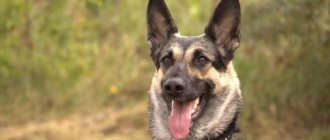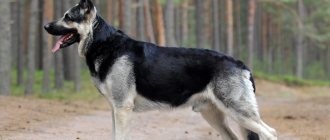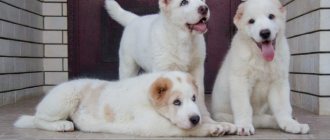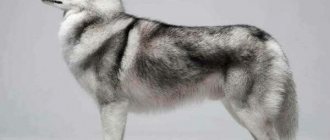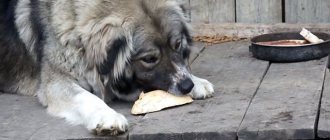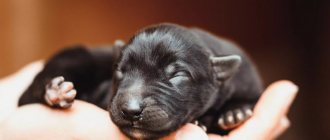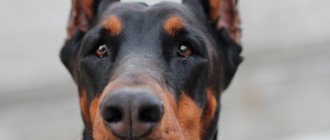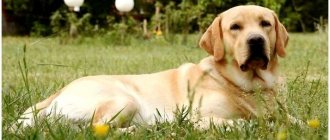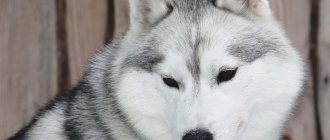The East European Shepherd is the personification of boundless devotion and enormous intelligence. Despite the fact that the breed is not recognized by world canine organizations, the smartest dogs are still actively bred and valued in the countries of the former USSR. Such determination of domestic dog handlers and loyalty to the breed is due to the outstanding qualities of the breed: amazing endurance, extraordinary intelligence, high performance and sincere friendliness.
VEO is a universal dog that will faithfully serve in law enforcement agencies or become a loyal friend and constant protector of all members of the owner’s family. Before purchasing a cute East European Shepherd puppy, it is useful for the future owner to learn everything about the breed: history of origin, standards and character, features of care, feeding and training.
Origin
The VEO breed is a direct descendant of the widespread and internationally recognized German Shepherds, which were bred at the end of the 19th century in northern Europe. Germans were considered herding dogs and were originally used only for cattle breeding. Shepherd dogs guarded livestock, chased predators, hunted game and faithfully served their master. Long marches with a shepherd in any weather conditions have formed the breed's protective instincts, endurance, efficiency, courage and loyalty to humans. Thanks to these qualities, Germans around the world began to be used in intelligence work.
Veo was bred for guard, search and military service
The European climate is much milder than the harsh conditions of the former Soviet Union, so German Shepherds had a hard time withstanding the freezing cold of the Far North or the heat of the eastern borders. At the beginning of the 20th century, by crossing Germans, Caucasians and Laikas, Soviet dog handlers created a new breed of shepherd dog, superior to its German counterparts in height and level of endurance. The East European shepherd dog breed was bred for use in various industries: for work in the guard, search and military services, the national economy and medicine.
History of the development of the breed
1904-1905 – during the Russo-Japanese War, the first mentions of “Easterners” are found, who served in the communications and sanitary services. In addition to an increased level of endurance and performance, the new breed was distinguished by unquestioning discipline, selfless devotion and high intelligence.
1922-1940 - with the coming to power of I.V. Stalin continued work to consolidate the positive qualities of the new breed. With increasing repression, the new government needed huge numbers of hardy guard dogs to guard prisoners. In 1924, the Krasnaya Zvezda kennel and service dog breeding clubs were created to control matings, select purebred sires and register offspring. For the further work of dog handlers and breeders who developed a new breed, new purebred German shepherd breeders were required. “German” puppies from Germany were purchased exclusively for foreign currency, but due to a shortage of financial resources and the injection of fresh blood, the selection of VEO was suspended until the end of World War II. During this period, East European and German shepherds in the USSR were often considered the same breed.
1941-1945 – during the Great Patriotic War, about 60 thousand individuals of East European Shepherds were actively used on the front line and in the rear, thanks to which the breed earned recognition and received the name of the most patriotic breed. In honor of the brave and selfless front-line dog, a bronze monument was erected on Poklonnaya Hill in Moscow, the prototype of which was VEO. After the end of hostilities, many adult trophy German shepherds remained on the territory of the USSR, which were used for further breeding of the breed and consolidation of outstanding qualities.
1964-1990 – VEO officially became considered a subspecies of the German Shepherd and received recognized breed standards in 1964 and 1976. Before the collapse of the USSR, Soviet cynologists carried out active breeding work to improve and consolidate the positive breed qualities.
East European Shepherd Efa, winner of exhibitions in 1965, 1966 and 1967.
1991-2002 _ – after the collapse of the USSR, the German Shepherd received an international standard, and the “Eastern Europeans” were recognized as an illegal breed. Representatives of the New Soviet breed were not allowed to participate in exhibitions and were excluded from cynological associations. During this difficult time, the Association of Breeding Kennels VEO and the Union of East European Shepherd Lovers were formed, which are still involved in breeding VEO, controlling matings, preserving the purity of the breed, holding exhibitions and competitions.
In 2002, the Russian Canine Federation officially recognized the East European Shepherd as an independent breed with the approval of modern standards.
History of the origin of the species
The ancestors of the East European Shepherd are considered to be German shepherds, which were brought to the territory of Tsarist Russia at the beginning of the 20th century - in 1904 . Initially they were used in the field conditions of the Russo-Japanese War. Dogs of this breed have proven themselves to be excellent in finding the wounded and notifying paramedics of their location. A little later, German shepherds replaced Dobermans in police service.
After the end of the First World War, German Shepherds began to be actively used for guard duty at military and border facilities, as well as for guarding prisoners in camps. German Shepherds perfectly met all the requirements of powerful and strong escorts.
The primary task of the young Soviet government was to ensure order, and therefore most of the service dogs that were imported into Russia from Germany were not intended to be used for breeding. Mostly “workhorses” were purchased, which had excellent security characteristics. However, the use of these dogs in the harsh conditions of the North, where the bulk of the settlement colonies were located, led to a sharp reduction in their number due to their low resistance to cold climates.
On the other hand, there was also no possibility of constantly replenishing the number of dogs, since they were purchased for foreign currency, the resources of which were limited.
Naturally, there is a need to select our own breed, which is not inferior in performance characteristics to the German Shepherd . It had to be a balanced dog, resistant to the climatic conditions of the country, with high security properties. Considering that German shepherds had all the necessary qualities, this particular breed was taken as the basis for selection.
The date of organized selection can be considered 1924, when the Red Star nursery was created, in which the first attempts were made to breed a new, universal breed. The West German line was used as a basis, but the lack of experience and proper funding did not lead to a positive result. By the beginning of the Second World War, no particular success in breeding had been achieved. In addition, most of the dogs died during the hostilities.
In the post-war period, the situation began to improve, largely due to the fact that magnificent “pure” examples of the breed ended up in the USSR along with German prisoners of war. Their breeding characteristics became the basis of the species now called the East European Shepherd (abbreviated as VEO).
Initially, selection was carried out by private individuals. However, very quickly, law enforcement kennels are included in the process, supplying dogs for breeding. Later, the newly created professional dog breeding clubs are involved. The purpose of founding the latter was the need to register and record puppies, to identify representatives of the breed most suitable for breeding. Finally, exhibitions begin to be held, based on the results of which adjustments are made to selection plans.
All events lead to the approval of the first BEO standard in 1964. Since its “official recognition,” the breed has been rapidly spreading and is a success not only among government officials. Ordinary people are beginning to pay more and more attention to massive and hardy dogs, which, unlike the German Shepherd, look more reserved.
In the 70s of the 20th century, Eastern European culture received well-deserved wide recognition.
Standard, description of appearance, color
The East European Shepherd is a fairly large, hardy dog with strong bones and prominent, lean muscles.
It is recommended to buy purebred babies from bona fide VEO breeders, since at a young age, two-month-old East European and German Shepherd puppies look almost the same.
Appearance of the East European Shepherd
Main characteristics of the breed according to the modern VEO standard:
Height
The height of an adult male at the withers is 66-76 cm, females - 62-72 cm. Males are larger and more massive, so it is quite easy to determine the gender of the dog by the appearance of the dog.
Weight
The weight of an adult male East European Shepherd is 35-60 kg, females - 30-50 kg.
Body
VEO has strong bones, prominent, toned muscles, an elongated straight body, rounded at the point where it becomes the tail. The neck is dense with pronounced withers, the chest is strong and wide. In the stance, the level of the chest is higher than the level of the croup.
Head
The dog's head is large, proportional to the body, has the shape of a wedge with a smooth transition from a wide frontal part to an elongated muzzle. The cheekbones are rounded and well muscled, the lips are dark and fit tightly to the jaw, the nose is black with wide open nostrils. The ears are straight, standing upright, the eyes are oval with dense eyelids.
Veo's head is massive and moderately long
Teeth
According to the standard, the animal must have 42 white large teeth, developed jaws and a scissor bite.
Tail
The dog should have a saber-shaped tail, which in a calm state falls below the hock joint, and when in service or protection rises above the level of the spine.
Limbs
VEO has high, strong paws with well-developed muscles in the upper part. The forelimbs should be level and parallel, the hind limbs should be at a slight angle back. The paws are round, compact, without dewclaws, the claws and pads are black.
Gait
The East European Shepherd is characterized by trotting and pushing with its hind legs.
Wool
The coat is hard, even, adjacent to the body, and the undercoat is well developed. The coat should be short and of equal length, with slight lengthening of the hair at the withers and hips allowed.
Color
The breed standard defines several colors of the East European Shepherd. Black saddle against a background of light colors from gray to fawn and rich black saddle are considered classic. Zone-red or zone-gray colors are allowed, but not recommended.
East European Shepherds of saddle-gray and saddle-black color
VEO puppy development by months
To be sure that your pet’s health is in perfect order, you need to keep a diary from birth in which you note the weight and growth of the East European Shepherd by month. The parameters will be normal if they do not differ greatly from the average weight accepted by the standards. The growth of the East European Shepherd is also monitored.
Weight and height of the East European Shepherd at birth
The birth weight of puppies depends on many reasons:
- number of heads in the litter;
- parental genetics;
- age of the whelping bitch;
- her health status (weight norm);
- maintenance (feeding, exercise) of a mated dog.
In a multiple litter, there are puppies that are small, less than 400 g, or very large, weighing more than half a kilogram. And this despite the fact that a newborn shepherd cub should weigh 400-500 g according to standards.
Boys are smaller than girls at birth - this is not something to be afraid of. But they quickly catch up with their sisters, and then completely overtake them.
Knowing how much the puppy’s mother weighs and how much the father meets the standards, we can assume whether their offspring will be large or small.
Small differences from the average figures are acceptable.
One month
During the first weeks, the kitten grows very actively. 30 days after birth, the height of the withers becomes 23-27 centimeters. Veo weighs from three to five kilograms at this age.
At the age of one month, puppies still need their mother's milk
At one month of age, small puppies gain weight faster than large ones, although they do not always catch up with them. But often even those who were smaller than standard at birth reach average parameters. During the first 4 weeks, the kitten increases its body weight by 6-8 times or more.
The monthly weight gain should be about 3-5 kg, and the height should increase by 2 cm. Cubs that weigh more than 5 kg per month subsequently grow into damp, loose dogs.
At the age of a month and a half, an East European Shepherd puppy looks like a small bear cub with rather short legs and an egg-shaped body. The hanging ears make him look like a cute soft toy.
Shepherd dogs are born toothless. By 4 weeks they already have both upper and lower canines.
Two month
At this time, the skeleton is actively being formed. The two-month-old puppy is trying to raise his ears, but the cartilage is still soft. The incisors should appear - the pet is trying everything around “by tooth”.
2 months - the period when baby incisors appear
Its weight reaches 8-10 kg - this is 20 more than at birth and 2 times more than at the beginning of the previous month. But due to their disproportionately short legs, the cubs still look like toys.
Three months
Starting from 2 months, the puppy's milk teeth are replaced with permanent ones. The holds fall out first, then the middle ones.
Over the past two months, the pet has increased its weight by 3-4 times, and since birth - by 30 times. A three-month-old puppy weighs from 12 to 15 kg. The length of the front legs has also tripled. Now he doesn’t seem like a clumsy bear cub - he’s already a small dog, although due to the fact that his ears are poorly held in a standing position, he looks like a defenseless and cute little kitten.
At three months, the ears may rise and then fall again - this is due to the growth of teeth
Four months
At this time, puppies are still changing their baby teeth. At four months, many Shepherd dogs develop their first molar from below. The four-month-old puppy continues to actively gain weight. She already reaches 15-20 kg. The height at the withers has also doubled compared to a month-old kitten.
The dog's ears, paws, and tail grow rapidly. Therefore, the pet often carries its tail, lowering it low to the ground. Most ears stand up well. The final period for “ears to stand up” is six months.
The joints on the paws are large, very prominent, and seem disproportionate compared to the body.
At 3.5-4 months, “Eastern Europeans” begin their first molt. The soft puppy fur is replaced by a tougher, “adult” one.
At the age of 4 months, intensive growth of the limbs is observed
Five months
After the fourth month of life, the shepherd's growth is a little slower than before. All parts of the body are formed and become more proportional. A five-month-old East European Shepherd reaches a weight of 20-25 kg.
Her milk teeth continue to be replaced by permanent ones, and molars appear - from 1 to 3 pieces.
Five months is the time when the first molars appear
Six to eight months
During this period, the pet grows very slowly and changes little. His ears should be saddle-backed and not roll over to one side, and his paws should be proportional to his slightly inclined body. Outwardly, a six-month-old teenager completely resembles an adult.
All the baby teeth have already been replaced by permanent ones, and all the molars have grown in.
Some individuals show signs of puberty at six months: males mark their territory, and females may begin their first heat.
Important! You shouldn’t follow nature’s lead at this time: early matings have a negative impact on the health of the animals and will stop their further development.
At the age of 6-8 months the body becomes more proportional
Nine to twelve months
The teenager's paws and head are already fully formed. The muzzle is no longer growing. In appearance, this is already a full-fledged dog.
However, it is impossible to say that the animal has grown. Slowly and almost imperceptibly, the shepherd continues to grow and take shape. Some individuals notice a slight increase in height at the withers.
By the age of one year, the shepherd's growth in height stops
One or two years
The shepherd has acquired its permanent color since the shedding is complete. There are no changes to the main parameters.
But it still continues to develop. Without significantly gaining weight, the dog grows “in breadth”: the chest increases, the muscles become stronger.
After a year, the shepherd's weight increases due to muscle gain
Two years and older
Finally, the owner can calm down: his pet has become quite an adult. The countdown has begun. From the age of one and a half years, shepherd dogs notice abrasion of their teeth: first the toes, then the incisors, then the canines.
Comparison with the German Shepherd
The East European Shepherd differs quite significantly from its German relative, due to which it was deservedly distinguished as a separate breed:
- VEO is much taller and larger than the Germans;
- The East European Shepherd has a straight back, the slope of the German ridge is about 23 degrees;
- the chest and paws of VEO are much wider and more massive;
- Easterners move at a trot with strong pushes of the hind limbs; Germans are characterized by a creeping trot;
- The colors of the East European Shepherd often have light tones, the Germans are darker;
- Easterners are distinguished by a calmer and more self-possessed disposition, in contrast to the playful Germans;
- VEO is wary of strangers; German Shepherds are much calmer about letting strangers in;
- Both breeds are easy to train, but German Shepherds quickly achieve better results for competitions, and in work they are smarter and more disciplined than VEO;
- Orientals are more often used in service dog breeding, and Germans are increasingly kept as pets.
Despite the fact that Noh and Veo are close relatives, there are still differences in physical development and abilities
East European Shepherd and German Shepherd: differences
The main differences between East European and German Shepherd dogs can be summarized as follows::
- Height – VEO is on average 5-7 cm taller than a “German”.
- Size – VEO is larger and more massive, looks leaner.
- The length of the croup is longer in the Eastern European breed.
- Color . The color of the German Shepherd does not include gray; the predominant colors are black and red.
- Temperament . VEO is considered more seasoned, adapted to perform guard tasks, while German shepherds are more energetic and are more often used on guard duty.
The East European Shepherd is an ideal friend, guard and protector. Possessing an even character, a high degree of trainability, and a pronounced ability to protect the owner, this dog is rightfully considered one of the most popular and desirable breeds.
5 / 5 ( 1 voice )
Features, character
East European Shepherds are distinguished by a calm, phlegmatic disposition, which allows the dogs to relate adequately to strangers and easily learn commands.
The main character features of VEO are:
Attitude towards the owner
The “Eastern” faithfully serves and unquestioningly obeys its owner; the smartest pet can understand a person without words. VEO is often used as a guide for blind or elderly people.
Attitude towards strangers
The East European Shepherd is wary of strangers, but thanks to its calm character and balanced psyche, it can adequately assess the actions of strangers.
Attitude towards children and other pets
Despite its impressive size and fighting appearance, the East European Shepherd loves children and is able to frolic with children for hours without harming them. The owner's children are perceived by the devoted dog as the main friends and objects of primary protection. “Vostochnik” does not offend other pets, which may even be several times smaller than VEO. Often adult dogs take care of and tenderly love pets who live in the same room.
Security qualities
“Easterns” immediately take a fighting position when danger arises for the owner and members of his family. The animal is fearless and selfless, and, if necessary, sacrifices its life to save a person.
Veo is the ideal watchman and guard of your property
Training
The dog's docile nature and owner-orientation make it easy to train. The pet does not try to dominate its owner and calmly goes through the general training course.
Education and training
The ability to obey the owner, remember and clearly carry out service commands is inherent in East European Shepherds at the genetic level; from the moment of acquiring a puppy, it is recommended to properly raise and train it. The sooner a dog is socialized, the more adequate his reaction to strangers and orientation towards the owner will be.
It is necessary to exercise the puppy for at least 15 minutes a day; early training helps to establish contact and mutual understanding with the dog. If it is difficult for a young pet to concentrate for 10-15 minutes, you can do 5-minute exercises several times a day, rewarding your pet with a favorite treat after each time.
To achieve excellent results in training, it is necessary to start training from childhood.
Monthly course of raising and training a VEO puppy
• 1 month . At the age of one month, the babies live with a breeder, who begins to accustom the dogs to communicate with people, wearing a collar, leash and muzzle. • 2 – 3 months . At this age, a young shepherd dog acquires a new owner, who teaches the baby to respond to a nickname, go to the litter box, and obey during walks. A pet should follow the simplest commands: “Come to me”, “Fu”, “Place”, “Teeth”, “Voice”. • 4-6 months . Up to six months, a young dog is taught to take hurdles, walk up stairs, and follow the commands: “Next”, “Sit”, “Lie down”, “Stand”, “Fetch”, “Give””, “Barrier”, “Forward”. • 6-8 months – At this age, the pet is taught to find hidden things by smell, guard objects, pursue and detain intruders. Such commands should be taught to the dog by an experienced trainer. • 1.5 years – the VEO puppy takes the OKD course and can learn guard, guard or protective-search service. It is necessary to train a puppy not only to establish contact and obey the will of the owner, but also to form a loyal, disciplined friend and protector from an unintelligent baby.
How to choose a puppy
Considering that East European Shepherd puppies are very similar to German Shepherd puppies, it is best to contact a kennel club and carefully study the manufacturer's documents, as well as the parents' show results, which are available on the Internet.
Since at the age of 1.5-2 months, when puppies are usually given to their owners, it is almost impossible to assess their character and performance characteristics, special attention must be paid to assessing the puppy’s parents.
- The behavior of the future adult VEO will in many ways resemble the behavior of the mother, and the protective qualities are better assessed by the puppy's father.
- Having a “T1” test and diplomas of successfully passed training courses (OKD, ZKS) will only be a plus . In addition, the level of mental stability of parents indirectly depends on factors such as living conditions and diet.
- If the dog is not kept on a chain, its coat looks well-groomed, most likely, we are talking about a balanced and calm dog.
- An important point is the contact between the future owner and the puppy. If it can be established in the first 5-10 minutes of acquaintance and play, this usually means that the puppy is ready to become a member of the “pack”.
- The puppy's health is assessed by its behavior - the puppy must be active and sociable. To avoid future problems with dysplasia, which is common in all large dogs, you can ask the breeder to take pictures of the hip and elbow joints. This is not a prerequisite for completing paperwork for a puppy, but most large and reliable nurseries practice it.
How to buy a purebred VEO puppy
In the 90s of the 20th century, they wanted to completely eliminate the “East European Shepherd” breed; therefore, acquiring a purebred “Eastern” is not entirely easy. At the age of two months, it is almost impossible to distinguish a young East European Shepherd from a German or a half-breed, so it is necessary to purchase a puppy from VEO kennels.
If you want to get a healthy and mentally balanced shepherd, you should only buy a Veo puppy from trusted breeders
Serious organizations involved in breeding East European Shepherds select sires, control all matings and register the resulting offspring. It is not always possible to purchase a puppy right away; in this case, it is possible to reserve a pet of the desired gender from selected manufacturers. A few months of waiting allows you to purchase a purebred “Eastern” with a good pedigree.
The cost of VEO puppies with documents from the Russian Canine Federation is on average 20,000 - 50,000 rubles, this is quite an adequate price for a purebred dog. If the proposed young East European Shepherd costs around 3,000 – 5,000 rubles, there is a high probability of purchasing a dog without a pedigree or a mixed breed.
Height and weight of an East European Shepherd puppy by month
A VEO puppy reaches the size and weight of an adult animal at 8-9 months, but muscle formation and an increase in the amount of subcutaneous fat continue up to a year. The build of a dog depends on heredity and the quality of feeding and maintenance of growing young animals.
Table of height and weight of the VEO puppy by month
| Age (in months) | Height at the withers of a male dog (cm) | Height at the withers of the bitch (cm) | Weight (kg) |
| 1 | 23-27 | 23-25 | 3-5 |
| 2 | 35-38 | 33-36 | 8-10 |
| 3 | 43-47 | 41-46 | 12-15 |
| 4 | 50-55 | 48-53 | 15-20 |
| 5 | 55-60 | 55-57 | 20-25 |
| 6 | 60-65 | 57-65 | 25-30 |
| 7 | 65-68 | 65-66 | 30-35 |
| 8 | 68-70 | 66-67 | 35-40 |
| 9 | 68-73 | 66-68 | 35-40 |
| 10 | 68-75 | 66-69 | 35-40 |
| 11 | 68-75 | 66-69 | 35-40 |
| 12 | 68-75 | 66-69 | 35-40 |
Changes also occur in other parameters of the shepherd dog.
How old do East European Shepherds grow?
The East European Shepherd grows most actively during the first year of life. The dog’s appearance changes, its proportions are formed, it matures and gains body weight. The animal also grows in height. Moreover, from the very first days, male dogs differ from girls of the same age - they are larger, more powerful.
Until seven or eight months, the most noticeable thing is how their height and weight increase. A table of animal growth during different periods of life will help you analyze whether this process is happening correctly in your pet. It shows the weight of the VEO puppy by month.
At 1 year old, the dog already looks quite grown up. She acquires the weight of an adult VEO, which should not change for the rest of her life.
Deviations of parameters indicate physiological changes in the body. In bitches this happens during pregnancy, feeding puppies, and childbirth. Sometimes a slight decrease in weight is observed due to ignored estrus.
Height and weight are the main indicators of puppy development
Important! After spaying and neutering, pets may begin to gain excessive weight. There are known cases of obesity after surgery.
If the weight of the East European Shepherd changes without an objective reason, this indicates:
- disease;
- incorrect content.
However, even after a year, East European Shepherds are still growing, as the body is being formed. They become adults at 2 years old. Some individuals grow up to 3 years, enlarging their chest.
Vaccination of puppies and adult dogs VEO
If VEO puppies are born from vaccinated mothers and fed with breast milk, the first vaccination against infectious diseases should be given to young pets at the age of 2 months. For vaccination, immunobiological preparations Nobivac, Eurican, Vanguard, Canigen, Duramune, Hexadog, Dipentavac, Hexakanivac are used for vaccination. Up to 12 months, young animals are vaccinated 3 times:
- at 2 months – first vaccination;
- at 3 months – revaccination;
- at 6-7 months – third vaccination.
At 15-18 months the fourth vaccination is carried out, the next vaccinations are given annually once a year. It is advisable to vaccinate young and adult animals in a specialized clinic, where a mark is placed in the veterinary passport on the date, dosage and name of the drug.
It is important to remember that before the first vaccination the puppy is vulnerable to infections.
The conditions for vaccination are:
- deworming 10-14 days before vaccination with antiparasitic drugs;
- absolute health – the dog three days before and on the day of vaccination should have a clean nose and eyes, good appetite and activity, normal body temperature;
- quarantine - until it reaches 2 months, it is forbidden to walk with an unvaccinated puppy. 3 days before and 10 days after vaccination, animals of any age should not change their diet, use increased physical activity, or bathe in the bathtub or open water.
Lactating, estrus and pregnant bitches, sick animals and puppies during their teeth change are not allowed to be vaccinated.
Care and maintenance
The East European Shepherd is an unpretentious breed that does not require special care. Preferred conditions of detention are an enclosure built in the courtyard of a private house. However, with the correct load, it is possible to keep it in an apartment.
In addition, there are recommendations that are common to all dogs - weekly checking of the ears and eyes (it is recommended to do it daily during tick activity). It is also necessary to trim the nails, and the dog must be accustomed to this process from the age of two months - many do not really like the procedure and often resist it.
If a dog eats natural foods, vitamins must be present in its diet. Most often, special additives are used for teeth and bones.
Nutrition
The nutrition of a VEO puppy is based on the following scheme:
- Puppies aged 2-3 months : 5 feedings, the volume of each feeding is 200 g, by 3 months the volume is gradually increased to 300 g;
- Puppies aged 4-6 months: 4 feedings, the volume of each feeding is from 300 g. at 4 months up to 400 gr. by 6 months;
- Puppies aged 7-12 months : 3 feedings, the volume of each feeding is up to 700 g.
After 12 months, puppies are considered adult dogs and are transferred to two meals a day, standard for large breeds, while the amount of food is reduced.
To calculate the daily intake of an adult dog, it is necessary to multiply its weight by 2-3%, depending on the level of expected physical activity. For example, for an average male weighing 50 kg. and high physical activity, the daily nutritional intake will be 1.5 liters (3% of body weight).
The diet and set of products are the same for puppies and adult dogs.
- In the morning feeding, it is preferable to give dairy products, while the use of high-fat cottage cheese is not recommended. It is best to buy cottage cheese with no more than 5% fat content. Twice a week, for example on Wednesdays and Saturdays, you need to add a fresh egg. Milk is allowed in a dog's diet, but it can have a laxative effect and is used individually.
- Evening feeding usually consists of meat - beef (for puppies up to 3 months in minced form), pork is completely excluded from the diet. You can use ocean fish in your diet (no more than 2 times a week) , but you need to keep in mind that the serving size should be doubled.
- If desired, the dog can be supplemented with porridge made from buckwheat or rice (for puppies, the use of cereals is mandatory) ; other types of cereals are poorly absorbed by the dog’s body. Vegetables in the amount of 50-100 g. should be present on the pet’s menu daily, in combination with vegetable oil (1 tbsp per serving of vegetables).
During the summer, we must not forget about the dog’s drinking regime - water should always be fresh and available at all times.
It is preferable to feed a VEO puppy with natural products. This will help gain muscle mass. But if this is not possible, it is better to use Premium dry food (Purina Pro Plan, Nutra) and Premium+ (Royal Canin, Nutra Gold, Hills). All of these companies have in their line both food for puppies and adult dogs; the required daily amount of food is indicated on the packaging.
Health
- The East European Shepherd is in good health, given the purposes for which this breed was created, and does not require a special daily routine.
- The dog adapts perfectly to any living conditions. The only thing you need to remember is that an active walk should last at least an hour.
Vaccinations
The vaccination schedule for young East European Shepherds is standard:
- Vaccination against plague, infectious hepatitis, parvovirus enteritis, parainfluenza and coronavirus infection is carried out at the age of 8-9 weeks, revaccination - at the age of 12 weeks.
- Vaccination against rabies is carried out at 8 weeks.
- Subsequently, both types of vaccination must be completed annually.
The conditions for vaccinating puppies of this breed do not differ from vaccinating dogs of other breeds - the dog must be healthy and must first be dewormed.
From the moment your dog consumes any anthelmintic before vaccination, at least 7-14 days must pass. If no worms are found in the dog's feces, repeated deworming is not carried out. However, if parasites are detected, vaccination should be postponed.
Diseases
Diseases specific to this breed have not been identified at the moment. They are subject to the same rules as all large breed dogs. Most often, East European Shepherds suffer from problems with the hip joints (dysplasia) , injuries to the ligaments and tendons. There have been cases of heart failure with little activity of the dog.
Walk
- Walking an East European Shepherd should be energetic.
- Running on the site and exercises are a way to ensure a dog’s long life.
- It is not recommended to feed your dog before walking.
- The duration of the walk should be at least an hour , and the interval between morning and evening walks should be no more than 8 hours .
- The dog does not need special clothing - a fairly thick undercoat helps in the winter, to which VEO is well adapted.
Bitches can be aggressive during periods of heat and get into fights with other dogs, mainly males.
Grooming
- East European Shepherds shed heavily , so they need to be brushed regularly. It is best to use a brush with natural bristles.
- If the dog does not shed, you can brush it 2-4 times a week , depending on the condition of the coat.
- During periods of shedding, the dog needs to be brushed on every walk , and it is necessary to pay attention to the condition of the croup - dandruff often appears during this period. In this case, you need to wash your pet with a special shampoo. Such unscheduled bathing will also help get rid of excess hair.
- It is not recommended to wash your dog frequently; 2-3 times a year will be quite enough, preferably during the transition seasons - spring and autumn. The use of a special shampoo is not necessary, but the use of flea and tick protection products is implied.
Care
East European Shepherds are fairly unpretentious creatures. A faithful dog must be provided with a permanent habitat, the necessary regular physical activity and decent nutrition.
The optimal place for keeping a large dog is an outdoor enclosure with a booth, but in case of frost or bad weather the animal should be allowed into a warm room. When keeping in apartment conditions, it is necessary to provide the pet with its own constant corner with bedding.
Hygiene procedures include bathing, cleaning ears, eyes and teeth, combing fur and trimming nails.
It is recommended to bathe your dog no more than 2 times a year, and brush your teeth and treat your ears preferably 2 times a month. Unnecessarily, you should not touch your pet’s organs of vision again, but if watery eyes and redness appear, you should rinse and instill the eyes with special drops. It is recommended to comb the dog 2-3 times a week with a special comb; this procedure is necessary for the health of the pet’s coat and skin.
Mandatory preventive procedures are treatment against ectoparasites, deworming and vaccination.
Antiparasitic and insecticidal drugs are given to the dog twice a year - in the spring and autumn, and also before the annual vaccination. Particular attention should be paid to protecting your beloved pet from ixodid and subcutaneous ticks; for this, drops on the withers, collars, tablets and sprays are used.
Breed characteristics
| Short description | |
| Origin: | USSR |
| Conditions of detention: | In an enclosure in the courtyard of a private house; under certain conditions - in an apartment |
| Purpose: | Service, security guard, sentry |
| Color: | Black-backed (solid) black, against a background of light fawn or gray to black shade of the main color, zoned with gray markings. Red shades are possible. |
| Wool length: | Average |
| Adult dog sizes: | Male: height (withers) – 66-76 cm, weight – 35-60 kg/ Bitches: height (withers) – 62-72 cm, weight – 30-50 kg |
| Average life expectancy: | 12-14 years old |
| Walk: | Required twice a day, minimum duration of at least an hour |
| Physical activity needs: | High need for exercise, requiring significant daily activity of more than 3 hours a day |
| Fédération Cynologique Internationale (FIC) classification: | The breed is not recognized |
| Puppy price: | From 20 to 75 thousand rubles. |
Feeding
You can feed VEO with natural food or ready-made industrial feed. When using factory-made food, it is necessary to choose a line for large breeds of dogs, taking into account the age and physiological state of the animal. Many well-known companies produce separate lines for puppies, pregnant and lactating bitches, and older large breeds. The daily dosage of feed is indicated on the manufacturer's factory packaging.
When using a traditional diet, the owner must prepare food for his beloved pet himself. This method is more energy-intensive, but natural food contains more beneficial nutrients. VEO's diet when using "natural" should consist of raw beef and sea fish (30-50%), cereals (20-30%), vegetables (5-20%), fermented milk products (20-30%), offal, fruits and healthy treats.
Life expectancy, health
There is no clear answer to the question of how long Eastern European Shepherds live. The average lifespan of a VEO ranges from 12-16 years, but sometimes dogs only live up to 9-10 years of age. The lifespan of a brave pet depends on heredity, the presence of chronic and acute diseases, the quality of care and nutrition.
Veos were bred to work in the harsh climate of the USSR, so they are very hardy and rarely get sick
East European Shepherds have a genetic predisposition to the following diseases:
- dysplasia of the elbow and hip joint - destruction of articular elements caused by genetic disorders, errors in feeding and excessive physical activity at a young age;
- arthritis and arthrosis - inflammatory and degenerative processes in the joints against the background of bone tissue regeneration or age-related changes;
- volvulus of the stomach or intestines - twisting of the stomach or intestinal loop after eating during physical activity. The pathology for VEO is deadly;
- rickets - a metabolic disorder caused by insufficient feeding, manifested by a characteristic curvature of the limbs;
- oncology – the formation of benign and malignant neoplasms on the dog’s body in the internal organs and tissues, which can cause premature aging and death of the animal;
- injuries to bones, ligaments and muscles during training and service.
With proper upbringing and training, the East European Shepherd becomes an irreplaceable friend, protector and outlet for a loving owner. A person who has had the happiness of communicating with VEO in his life remains fascinated by this worthy and smartest dog for the rest of his life.


